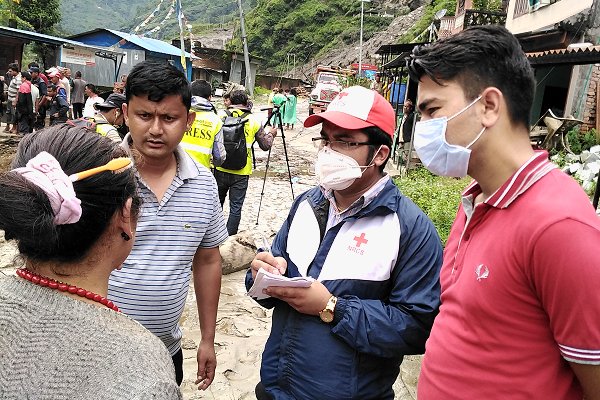
Humanitarian crisis worsens from South Asia floods as nearly 10m people affected

(This story is an IFRC press release issued Wednesday in Kuala Lumpur, Delhi, Dhaka, Kathmandu and Geneva)
A humanitarian crisis is deepening in South Asia as new figures reveal that more than 9.6 million people have been affected by monsoon floods, devastating large areas of India, Bangladesh and Nepal.
Jagan Chapagain, IFRC Secretary General, said: “Millions of people across Bangladesh, India and Nepal have been marooned, their homes damaged and crops destroyed by floods that are the worst in recent years.
“Every year there are monsoon floods, but this year is different as it comes at the height of a deadly Covid-19 global pandemic.
“Tragically, already 550 people have lost their lives and more than 9.6 million people have been swamped across South Asia.”
Close to one third of Bangladesh has already been flooded with forecasts of worse flooding in the coming days.
‘People are sandwiched in a triple disaster of flooding,
the coronavirus and a socioeconomic crisis
of loss of livelihoods and jobs’
More than 2.8 million people have been affected, including close to 1 million who remain isolated and surrounded by floodwaters, according to the Bangladesh Ministry of Disaster Management and Relief.
In India, more than 6.8 million people have been affected by severe floods, mainly in the northern states of Assam, West Bengal, Bihar and Meghalaya bordering Bangladesh, according to the Indian National Emergency Response Centre.
In Nepal, flooding and landslides have already killed close to 110 people. Across India, Bangladesh and Nepal, 550 have died according to government figures. Millions have been displaced from their homes.
“People in Bangladesh, India and Nepal are sandwiched in a triple disaster of flooding, the coronavirus and an associated socioeconomic crisis of loss of livelihoods and jobs,” Mr Chapagain said.
“Flooding of farm lands and destruction of crops can push millions of people, already badly impacted by the COVID-19, further into poverty.”
At-risk families
The IFRC has released more than 800,000 Swiss francs (US$ 850,000) to support Bangladesh Red Crescent relief activities, including more than 230,000 Swiss francs released last month when flood forecasts signalled the extent of the potential impact.
Volunteers in India, Bangladesh and Nepal are helping with shelter, providing tarpaulins, dry food and hygiene kits, and are installing pumps for safe water.
In Bangladesh, Red Crescent teams have distributed cash grants to help more than 35,000 people cope with the flooding. In India, over 9,200 tarpaulins have been distributed to most at-risk families. In Nepal, Red Cross teams are airlifting relief supplies to communities that cannot be reached by road.
Many communities in Bangladesh and India are still recovering after Cyclone Amphan damaged or destroyed more than 260,000 homes and crops and infrastructure two months ago.
The Nepal Red Cross Society has been distributing shelter materials, blankets, buckets and other relief items in Sindhupalchok district, where the flooded River Bhotekoshi washed away 36 homes. Local Red Cross volunteers were among the first ones to assess the situation and support the affected families. The National Society says casualties from landslides and floods over July have been greater than from Covid-19. (Photo: Nepal Red Cross via IFRC.)